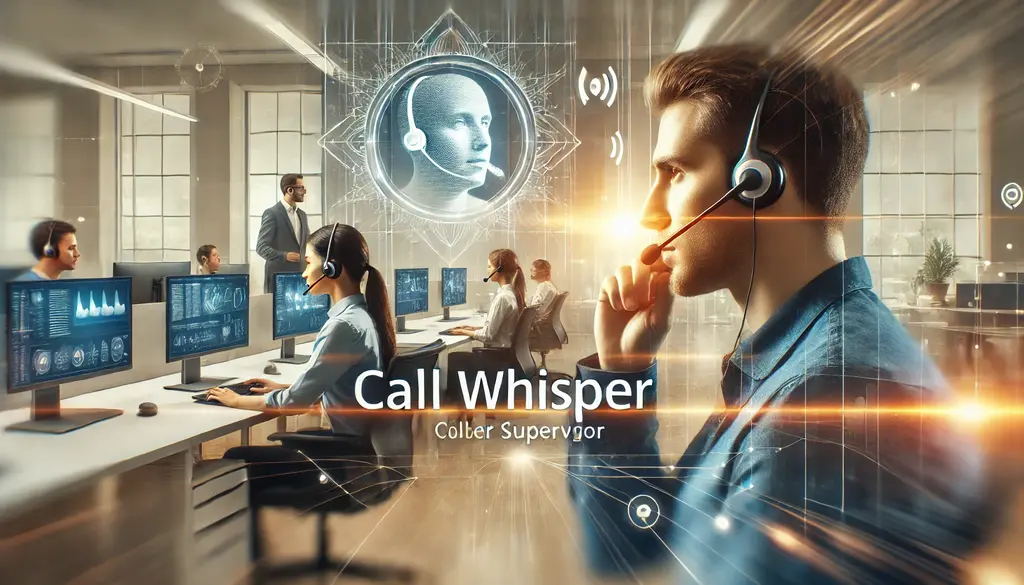Today, customer interactions play a crucial role in building a brand’s reputation. Every conversation counts, whether it’s a potential sale or a support request. Companies are constantly looking for ways to ensure their teams perform at their best during every call, and that’s where call whisper technology comes into play.
This feature, often found in call center software, allows supervisors to guide agents in real time without interrupting the flow of conversation with the customer.
But what exactly is call whisper? How does it work, and why should businesses invest in it? This article dives deep into everything you need to know about call whisper, including its benefits, how it compares to other tools and practical use cases.
By the end, you’ll understand why call whisper can be a game-changer for any customer-focused business.
What is Call Whisper?
Call whisper is a feature that enables supervisors to provide real-time assistance to call center agents during a live call without the customer hearing it. Essentially, it allows managers to “whisper” instructions, tips, or support to the agent through their headset. The key is that only the agent hears this communication; the caller remains completely unaware.
Imagine a scenario where a new agent is on a sales call, and the customer throws a curveball question. The agent may not know the answer right away, but instead of fumbling, the supervisor can whisper the correct response, helping the agent handle the situation smoothly. This is what makes call whisper so effective—it’s a form of real-time coaching that doesn’t disrupt the customer experience.
Unlike other call center features like call monitoring, where supervisors can only listen, call whisper allows for active engagement. It strikes a balance between letting agents manage calls independently while still having a safety net to guide them through difficult scenarios.
How Call Whisper Works?
The functionality of call whisper is integrated into call center software systems, making it easy for supervisors to use without causing any disruption to the call. Here’s a simplified look at how it typically works:
- Call Initiation: The customer places a call, which is routed to an available agent.
- Supervisor Access: The supervisor can listen to the call as it progresses, monitoring how the agent is handling the conversation.
- Real-Time Assistance: If the agent needs help, or if the supervisor notices an opportunity to improve the interaction, they can press a button or use a specific command to “whisper” guidance to the agent.
- Continuous Monitoring: Throughout the call, the supervisor can continue offering tips, answers, or feedback as needed, ensuring the agent has all the support they need to close the sale or resolve the issue.
The beauty of call whisper lies in its subtlety. The customer on the other end of the line remains completely unaware of the supervisor’s input, so the interaction feels smooth and natural. It’s an ideal way to coach agents without intruding on the customer’s experience.
Benefits of Call Whisper
Call whisper provides a multitude of benefits for businesses, particularly those with sales and customer service teams. Let’s explore some of the most significant advantages.
Real-Time Coaching and Training
One of the primary benefits of call whisper is the ability to coach agents in real time. In a traditional training environment, agents may go through weeks of onboarding and practice, but once they’re on a live call, they’re on their own. Call whisper changes that dynamic by allowing supervisors to offer immediate feedback and guidance during real interactions.
This is especially beneficial for new agents who may need extra support while they’re still learning the ropes. It helps bridge the gap between training sessions and actual on-the-job performance, ensuring agents learn faster and more effectively.
Enhanced Sales Performance
For sales teams, timing and precision are everything. A well-timed suggestion or the correct phrasing can make the difference between closing a sale and losing a customer. Call whisper allows sales managers to offer that critical input without interrupting the flow of the conversation.
Imagine an agent is trying to close a deal, but the customer raises an objection. Instead of struggling to come up with a response on their own, the agent can get real-time guidance from a more experienced manager. This can lead to higher conversion rates, better sales outcomes, and ultimately, increased revenue.
Improved Customer Service Quality
In customer support, delivering the right answer quickly can make or break the customer’s experience. Call whisper helps ensure that agents provide accurate information and solve problems efficiently, even if they’re dealing with a particularly challenging or unfamiliar issue.
When supervisors can guide agents on how to handle specific requests or de-escalate a tense situation, it improves the overall quality of service. Customers get the right information without long pauses, and agents feel more confident in their responses.
Boosts Confidence and Reduces Stress
Knowing that help is just a whisper away can significantly reduce stress for agents, especially those who are new or handling complex calls. It boosts their confidence, knowing they’re not alone and can rely on immediate support if needed. This, in turn, leads to better performance, lower turnover rates, and a more positive work environment.
Use Cases of Call Whisper
Call whisper is versatile and can be applied in various scenarios across different industries. Here are some common use cases where this feature can have a significant impact:
Sales Training and Support
For companies with sales teams, call whisper can be an essential tool for training new reps. Sales managers can listen in on live calls and guide new agents through their pitches, helping them learn how to handle objections, highlight product features, and close deals.
Over time, agents become more adept at managing calls on their own, but the call whisper feature ensures they have support during those crucial first few interactions.
Customer Service Escalations
When a customer has a particularly complex or urgent issue, call whisper can help agents navigate the situation effectively. Supervisors can guide them on how to handle the issue, what to say, and what actions to take without the customer being aware. This can be particularly useful for troubleshooting technical issues or managing sensitive requests.
Crisis and Conflict Management
Sometimes, agents find themselves in difficult conversations where the customer is frustrated or upset. In such cases, call whisper allows supervisors to suggest calming language, de-escalation techniques, or solutions that can diffuse the situation without making it obvious that the agent is receiving help. This subtle form of intervention can be critical in maintaining a positive brand image.
Ensuring Compliance and Quality
In regulated industries like healthcare, finance, or legal services, ensuring compliance is non-negotiable. Call whisper can help supervisors make sure that agents follow all necessary protocols and legal guidelines during their calls.
If an agent deviates from the script or misses a crucial point, the supervisor can quickly step in with a reminder or correction.
Call Whisper vs. Other Call Center Features
While call whisper is highly effective, it’s important to understand how it differs from other common call center features, such as call monitoring and call barging.
Call Monitoring
With call monitoring, supervisors can listen to calls without interacting. This feature is passive and is primarily used for performance assessment or training purposes.
While it allows supervisors to observe how agents are performing, it doesn’t allow them to step in with immediate help, which can sometimes lead to missed opportunities or errors.
Call Barging
Call barging allows supervisors to actively join a conversation. Unlike call whisper, which is discreet, call barging is transparent to both the agent and the customer. This feature is useful when a situation needs immediate intervention, but it can sometimes disrupt the call or make the customer feel uncomfortable.
Call whisper sits between these two features. It allows supervisors to guide and coach without disrupting the call. It’s an ideal solution for real-time coaching, where subtlety and discretion are key.
Choosing the Right Call Whisper Solution
Not all call whisper solutions are created equal. When selecting software that includes this feature, there are a few key considerations:
- Ease of Integration: Make sure the call whisper feature integrates smoothly with your existing call center software. It should be easy to set up and use without requiring extensive technical support.
- Intuitive Interface: Supervisors should be able to activate and use call whisper quickly and without fumbling. The interface should be straightforward, allowing them to focus on the conversation rather than navigating complex menus.
- Additional Features: While call whisper is important, it’s often best when combined with other tools like call recording, performance reporting, and call analytics. These features can give supervisors a comprehensive understanding of how agents are performing and where they may need additional training.
Conclusion
Call whisper is a powerful tool that can transform the way businesses handle customer interactions. Providing real-time guidance without interrupting the call, it enables sales teams to close more deals, customer service teams to solve problems more effectively, and managers to ensure compliance and quality across all interactions. It’s a subtle but incredibly effective way to enhance performance and improve the customer experience.
Whether you’re training new agents or managing a seasoned team, call whisper can provide that extra layer of support that helps everyone succeed. Investing in this feature is not just about improving immediate call outcomes; it’s about building a more confident, competent, and effective team that can handle any challenge thrown their way.
FAQs
What is the difference between call whisper and call barging?
Call whisper is a private coaching tool where only the agent hears the supervisor, while call barging allows the supervisor to join the conversation directly, making themselves audible to both the agent and the customer.
Can call whisper improve sales conversions?
Yes, it can. By providing real-time coaching, supervisors can guide agents through difficult conversations, helping them close deals more effectively.
Is call whisper suitable for small businesses?
Absolutely. Call whisper can benefit businesses of all sizes, helpingfor new agents, or helping seasoned pros handle tricky customer interactions. When used effectively, call whisper can be a key differentiator, boosting your team’s confidence, efficiency, and overall performance.








